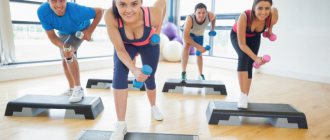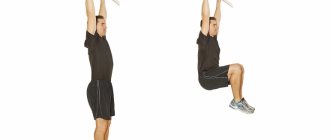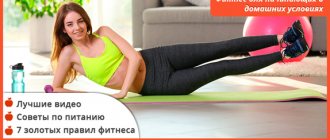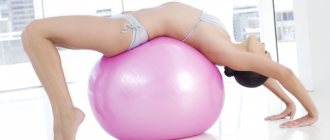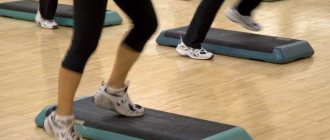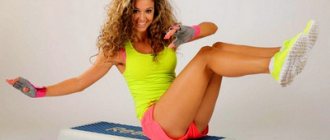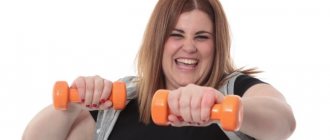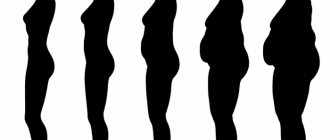06/29/2019 Olga Migunova 0 comments
Step aerobics will help you take the first step towards toning your body. The muscles will tighten, become more elastic, and the figure will be more prominent.
When you want to lose weight, but you understand perfectly well that exhausting diets are more likely to cripple than help you lose weight, more and more often you begin to think about gyms, fitness and other physical activities.
At the same time, you understand perfectly well that a body unaccustomed to sports will strenuously resist violence, get sick, turn into jelly and be completely unable to even get out of bed, and not just get out of it. What can you do that is not difficult, not very painful, but effective?
Today we will look in detail at all the subtleties that step aerobics includes for beginners, and we will also analyze how effective it is and whether there are hidden pitfalls in such activities.
History of creation
Thirty years ago, American Jean Miller, who leads fitness classes for those who want to lose weight, injured her knee. He was cured, but in order to strengthen the leg muscles after the injury and restore motor functions, the orthopedist advised the girl to go up and down the stairs as often as possible. It was very important for Jean to return to work, so she trained every free minute.
The first “exercise machines” for her were the steps of the porch, as well as a milk crate, which she used for training at home. It was boring to do monotonous movements, so Jean began to turn on music and tried to move to its rhythm. In a short time, the knee joint was restored, and Jean Miller developed a new fitness program to keep her body in good shape.
Translated from English, the word “step” means “step”, which is exactly how the new direction in aerobics was named.
Already in the mid-nineties, more than nine million Americans and the same number of people in other countries were engaged in a new type of fitness. Step aerobics was rapidly gaining popularity and is still practiced today.
History of tap dance
Step aerobics was invented by US bodybuilding champion Gina Miller. After a knee injury, she could not return to her usual training for a long time, but her body and soul craved sports activities. Without thinking twice, Gina began training on the steps of the porch of her own house.
The athlete was so carried away by the exercises she had invented that she did not notice how the injury on her knee stopped bothering her, and the woman herself quickly regained her lost athletic form.
https://youtube.com/watch?v=SM-_flc_Y9s
Miller was convinced on her own body that the simplest exercises on the steps led to stunning results. It was this fact that prompted her to create a completely new direction of aerobics, based on movements from her home rehabilitation program.
What is step aerobics
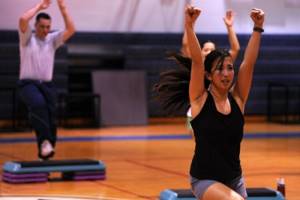
Aerobics or rhythmic gymnastics is a set of aerobic exercises performed to music, which sets the rhythm and tempo.
Step aerobics is one of the simplest and most effective types of regular aerobics.
Mechanism of action
The essence of step aerobics is rhythmic steps to music. All exercises are performed using a special platform, the height of which can be adjusted based on the user’s physical data.
Thanks to exercises, large muscle groups are trained, weight is lost and the cardiovascular system is strengthened. At the same time, the load on the musculoskeletal system is low, which allows you not to overwork during training, of course, provided that the right pace is selected.
Types of activities
During one standard workout, exercises of different nature and intensity are performed.
The lesson can be divided into several complexes.
- Warm up.
- Follow the basic steps.
- Alternating strength and cardio exercises, which are vigorous aerobic exercises and “swinging” the press.
According to the level of training of those involved in step aerobics, aerobics can be classified as follows.
- Basic Step. These are the first steps for beginners who are just mastering movement techniques and simple exercises.
- Advanced Step. Designed for experienced users and includes not only steps, but also jumps, as well as various combinations and modifications.
- Dance Step. Develops flexibility and grace with the help of complex choreographic elements and exercises.
- Step-combo. Complex exercises at an intense pace.
- Interval mode (Step Interval). A combination of exercises at a calm and explosive pace. Ideal option for weight loss.
- Double Step. To increase efficiency, two platforms are used at once.
- Power Step. A combination of strength and aerobic exercise.
Types of aerobic direction
The workout, called “step aerobics,” provides a regular lesson for people with average fitness for physical activity. At this stage, everyone chooses the height of the platform for themselves. However, if this is your first time at a lesson, it is better to clarify everything with the trainer.
There are several types of step aerobics:
- Basic Step. Classes are designed for beginners to learn basic steps and easy connections;
- Advanced Step. The exercises are designed for advanced people who have been practicing for a long time and have experience in this field. Usually the training consists of a complex complex with jumping;
- Dance Step. This load is created for dance lovers. The lesson includes combinations from dance styles, which contributes to the development of plasticity and grace;
- Step-combo. A combination of the most difficult steps for people with good coordination and endurance;
- Step Interval. If we are accustomed to the fact that classic step aerobics takes place continuously, then this type provides an interval method. Burst intervals alternate with recovery periods;
- Double Step. A new direction in aerobic sports, when two platforms are used. In this case, the effectiveness of training increases significantly;
- Power Step. This type of step aerobics involves performing strength exercises to increase the tone of muscle tissue.
Pros and cons of step aerobics
Advantages:
- no special training required;
- It is not necessary to have dancing skills;
- “steps” are simple and accessible even for beginners;
- minimum inventory;
- you don’t need a lot of space for classes;
- movements are “not boring”, they are distinguished by variety and the ability to complicate them for “advanced” users;
- in one lesson you can “burn” from 300 to 500 kcal;
- the load on the joints is not as great as plyometrics or jumping rope;
- the impact is aimed at the lower part of the body, the most “problematic” in women;
- develops endurance, agility, coordination and balance;
- by adjusting the height of the step platform, you can increase or decrease the load;
- the ability to practice at home using video lessons and with a step platform;
- Regular training helps to lose weight, strengthen and “tighten” the figure, and have a beneficial effect on the cardiovascular, nervous and respiratory systems of a person.
Flaws:
- the first lessons can be difficult, since beginners cannot keep up with the trainer and do not remember the movements - this discourages them from practicing further;
- step aerobics has less impact on the knees and ankles than running or jumping, but if you suffer from diseases of the knee or ankle joints, then you should consult your doctor about the advisability of exercise;
- each instructor builds a training methodology in his own way, sets the rhythm and intensity, but the human factor and mistakes have not yet been canceled - not everyone will be suitable for a trainer and his style of conducting training;
- step aerobics is aimed at working the muscles of the lower body, while the upper part does not receive the necessary load;
- Failure to follow proper step technique and improper footwear can lead to injuries and sprains.
Consultation “Use of step aerobics to increase physical activity of preschool children”
Olga Gubanova
Consultation “Use of step aerobics to increase physical activity of preschool children”
Consultation “Use of step aerobics to increase physical activity of preschool children”
The problem of health and its preservation in modern society is more than acute. Scientific research indicates that most modern children experience a “motor deficit.” As a result, the strength and performance of skeletal muscles decrease, which entails poor posture, curvature of the spine, flat feet, delayed age-related development, speed, agility, coordination of movements, endurance, flexibility and strength.
Due to the increasing interest of children in physical education activities with musical accompaniment and the fact that every year more and more children have health problems, we are introducing step aerobics classes into the system of physical education and health work of the preschool institution. Aerobics classes can effectively satisfy this need in a form that is accessible and interesting for children.
Aerobics is a system of physical exercises that provide energy through the use of oxygen. To achieve a positive effect, the duration of aerobic exercise should be at least 20-30 minutes. It is cyclic exercises aimed at developing general endurance that are characterized by the most important morphofunctional changes in the circulatory and respiratory systems. Aerobics classes organically combine dance and play exercises that children can perform without apparent difficulty. This allows not only to prepare children for a healthy lifestyle, but also develops their creative imagination. Aerobics is one of the effective forms of increasing the physical activity of children; such activities increase the functionality of the cardiovascular, nervous and respiratory systems, develop coordination and musicality, flexibility and plasticity of movements, and also give children great pleasure. One type of aerobics is step aerobics.
Step aerobics is gradually gaining its place in physical culture. This is facilitated by the positive emotional background of classes, mandatory musical accompaniment, and an unusual combination of movements associated with an unusual object - a platform. The effectiveness of step aerobics lies in the comprehensive development of motor qualities in children and the beneficial effect on their body (on the musculoskeletal system, cardiovascular, respiratory and nervous systems). The specificity of step aerobics is a combination of basic exercises with elements of dances of various styles, a close connection of movements with music and rhythms, high dynamism and variety of movements and, therefore, enriching motor experience and increasing the culture of movements.
Step aerobics is a health aerobics exercise using a special step platform with adjustable height. In the ground part of the lesson, the platform is convenient to use for developing strength. The movements are based on basic aerobics steps and dance stylization of exercises. Such movements are accessible to almost everyone. Thus, children with different levels of training can study in the same group at the same time, and the physical activity for each will be individual.
The main content of the classes are basic steps, running and jumping, which form the basis of classical aerobics. The use of step platforms in strength training is very effective and varied.
Equipment for step aerobics
– this is a platform 10 cm high, 20 cm wide, 40 cm long, leg height 7 cm, leg width 4 cm.
Lesson structure and musical accompaniment.
An aerobics class has three clearly defined parts (each consisting of subparts).
The first part of the lesson is an aerobic warm-up (from 4-5 minutes) at a musical tempo of 118-120 beats/min. and preliminary stretching lasting from 10 to 15 seconds. For one muscle group.
The second part of the step class - aerobics - aerobic part (15-18 min.) This is a set of exercises with gradually increasing intensity and necessarily a gradual decrease in intensity (the pace of movements slows down). In addition, strength exercises based on muscle groups not used in previous work are included.
The third part of the lesson is the subsequent reduction in load. These are slowly performed flexibility exercises (3-5 minutes). Their goal is to increase the length of the working muscle and accelerate blood metabolism.
The structure of the lesson may have different options in the content and duration of both individual parts and the entire lesson.
In physical education classes, the step platform can be used:
• In the introductory part: walking on and between steps (to form correct posture);
• When performing general developmental exercises to music: strengthening the respiratory and cardiovascular systems, developing coordination of movements;
• In the main types of movements: walking, jumping, running;
• In outdoor games.
Step aerobics classes give children great joy and a desire to engage in physical exercise. These activities are always accompanied by cheerful, rhythmic music, which puts children in a good mood. The selection of music for each exercise is of great importance. It simultaneously serves as a motivating factor, guides the progress of the workout and dictates the speed of movement. When selecting musical accompaniment, it is necessary to be guided by the presence in the composition of a clear percussive rhythm, tempo and duration.
The step aerobics technique involves constantly maintaining correct posture. Therefore, it is very important to remind children to maintain correct body position during all movements.
To maintain correct body position during step aerobics, you must:
1. Keep your shoulders back, chest forward, buttocks tight, knees relaxed;
2. Avoid overstraining the knee joints;
3. Avoid excessive arching of the back;
4. Do not bend forward from the hip, bend with your whole body;
5. When lifting or lowering from the step platform, always use a safe lifting method;
6. Standing facing the step-platform, rise using your legs, but not your back;
7. Keep the step platform close to your body when carrying it.
It is necessary to follow the rules for working on step platforms, which ensure safe behavior and prevent injury during classes. The rules of step aerobics are aimed at preserving and strengthening the musculoskeletal system of children. These rules relate to the height of the platform, posture, technique for performing a step up and step down, hand movements, and music.
Basic rules of step technique - training:
1. Perform steps to the center of the step platform;
2. Place the entire sole of your foot on the step platform when ascending, and when descending, place your foot from toe to heel before taking the next step;
3. When descending from the step platform, remain standing fairly close to it. Do not retreat more than the length of your foot from the step platform;
4. Do not start teaching children how to use their hands until they have mastered the movements of their legs perfectly;
5. Do not rise or fall from the step platform while standing with your back to it;
6. Take a step with ease, do not hit the step platform with your feet.
Step aerobics in kindergarten is carried out in various variants:
- in the form of a separate additional lesson, not excluding program ones;
- as part of a lesson;
— in the form of morning exercises, which helps to quickly bring the body into working condition, maintain a high level of performance during the day, improve the coordination of the neuromuscular system, the activity of the cardiovascular and respiratory systems;
- in the form of demonstration performances by children at music and sports festivals.
When distributing exercises, it is necessary to correctly dose physical activity, i.e., the heart rate (HR) should not exceed acceptable standards for children of this age.
With children 5-7 years old, step aerobics can be used without leading exercises. In our opinion, step aerobics should be included in different parts of the class. Conducting the entire lesson using step aerobics is not rational due to the fact that children quickly get tired of monotonous movements, as a result of which interest in the lesson decreases. To maintain the density of the lesson, it is more advisable to use step aerobics in any part of the lesson, but no more than 5-10 minutes. The arrangement of step platforms in classes with children of senior preschool age can be any: ledges, in a checkerboard pattern, in a circle, in a square, etc., step platforms can be placed closely or at intervals.
Children of primary preschool age perceive step aerobics classes positively. Leading exercises for doing step aerobics with children aged 3-4 years are learning the simplest steps and combinations used in step aerobics in a limited space (markings on the floor); It is also worth highlighting in color the place where the foot should be located; if the exercises include alternate steps from the right and then from the left leg, it is necessary to mark in color where the right and where the left leg should be placed (for example, for the right leg - blue, for the left leg - red).
It is important to note that during step aerobics classes, the child’s personality is formed, moral and volitional qualities are developed, and his character is formed. This will help him in later life.
Thus, the use of a step platform in the physical education of children of senior preschool age forms in them: a persistent interest in physical education classes, in their achievements, coordination of movements develops, the ability to navigate in space has also become clearer, which is one of the most important conditions for the formation motivation for a healthy lifestyle and achieving the best results.
Bibliography:
1. Belova T. A. Using a step platform in recreational work with children // Directory of a senior teacher of a preschool institution 2009 No. 7
2. Dolgorukova O. Fitness aerobics // Hoop 2005 No. 6
3. Kuzina I. Step aerobics for preschoolers // Preschool education, 2008 No. 5
4. Kuzina I. Step aerobics is not just fashion // Hoop 2005 No. 1.
5. Pogontseva L. Bench – step // Hoop. – 2003. – No. 2. – P. 33
6. Stepanenkova E. Ya. Physical education in kindergarten. – M., 2006
7. Strelnikova N.V. “Step-Dance” - a step towards health // Preschool pedagogy. – 2011. – No. 1. – P. 6.
Indications and contraindications for classes
If you are healthy and do not suffer from chronic diseases, then step aerobics will only benefit you. It is also indicated for those who complain of excess weight. Orthopedic doctors recommend it as a rehabilitation treatment after injuries to the lower extremities, in particular for developing joints and strengthening the muscle mass of the legs. However, in the case of therapeutic rehabilitation, you should limit yourself to a low level of intensity and use exclusively the first stage of the step platform.
Step aerobics is also beneficial for children. It is introduced as physical education classes in many preschool institutions.
For a growing body, such activities contribute to:
- harmonious development of the musculoskeletal system;
- correct posture;
- development of movement coordination;
- strengthening the respiratory and cardiac systems;
- improving mood and resistance to stress;
- general physical development and strengthening of the muscle corset.
Step aerobics is contraindicated for people suffering from the following diseases:
- knee and ankle joints;
- musculoskeletal system;
- of cardio-vascular system;
- varicose veins;
- atherosclerosis;
- hypertension.
It is not recommended for people with kidney failure, liver pathologies, gallstones, or exercise-induced asthma.
Such loads are contraindicated during pregnancy, as well as within three months after childbirth.
Step aerobics is not harmful, but its incorrect and incorrect use can lead to adverse consequences.
Effect on the body
Step training has a beneficial effect on the entire human body. The main benefits delivered by classes:
- Increasing the speed of metabolic processes;
- Elimination of fat deposits;
- Strengthening the muscular skeleton;
- Increases the body's endurance.
In addition, physical exercise affects the synthesis of necessary hormones. You should not be afraid that as a result of regular training, you will resemble a bodybuilder with large muscles. Step aerobics does not allow you to pump up your muscles, but only tones them, due to which the figure becomes toned.
How effective is step aerobics for weight loss?
Many people, in order to lose weight, go on strict diets and torture their bodies by limiting certain foods. As practice shows, all these diets are ineffective - weight is undoubtedly lost, but this does not happen due to fat loss, but due to dehydration and loss of muscle mass. As soon as someone who is losing weight returns to their usual diet, the weight returns very quickly, and even extra pounds appear.
Physical activity with poor nutrition also brings little benefit. The figure is tightened by strengthening the muscles, but the fat still won’t go away, no matter how hard you try.
Step aerobics for weight loss in itself is useless or has low effectiveness. But if you combine exercise and proper nutrition, the result will be extremely positive.
Need to:
- exercise three to four times a week;
- training should last no more than an hour;
- the majority of the complex should consist of aerobic exercises, but in combination with strength exercises;
- exclude fast carbohydrates from the diet - sugar, sweets, baked goods, processed foods, fast food, sausages, pickles and smoked foods;
- observe fractional meals and drinking regime.
In order for the body to start burning fat, it needs to ensure an increased heart rate through cardio exercise. If you keep your heart rate elevated at 70% of the average heart rate for 20-25 minutes, you can achieve weight loss. But it is worth remembering that such a load should not last more than 40-45 minutes.
Step aerobics classes help to correct the figure, influence fat deposits by increasing blood circulation, obtaining additional energy and vigor, as well as improving the overall emotional state, which often helps reduce appetite.
Recommendations for Beginners
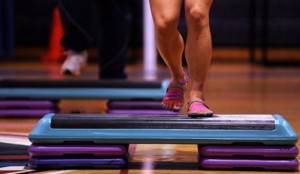
The basic rules that should never be neglected are as follows.
Rule No. 1. Exercise technique
Step aerobics is considered one of the simplest and safest types of physical activity. However, it is important to understand that if you place your foot on the platform incorrectly, you can suffer a dislocation, sprain, or other injury.
The foot should always be completely on the surface! Not on the toe, but flat.
When lowering your foot to the floor, make sure that your heel is also pressed against the floor - there should be no jumping or bouncing. Knees slightly bent, back straight, look ahead or at the instructor. Steps should not be wide, that is, when returning, you should not put your foot far away.
Rule No. 2. Tempo and rhythm
The intensity of the exercises depends on how fast the musical accompaniment is.
In regular aerobics, four types of tempo are practiced:
- NON Impact – unstressed;
- Low Impact - low impact;
- High Impact - high impact;
- High Low Impact – combined.
For beginning “step players”, a low-impact tempo is used with a music rhythm of 128-133 bpm.
This is the safest type of fitness, which is also recommended during the rehabilitation period for injuries to the musculoskeletal system. In this case, one leg is always the supporting leg, that is, it is on the floor. More “advanced” and trained users perform exercises of increased complexity, when both legs are “in flight” - jumping and all kinds of movements. Moreover, the tempo increases to high-impact. The maximum permitted rhythm of music is 136 bpm.
If you increase the intensity even more, as many people who exercise with the silent support of fitness instructors prefer to do, then if the movement is unsuccessful, you can get serious injury, including a fracture. In addition, a fast pace somehow increases the load on the knees, ankles and spine.
Remember the founder of step aerobics. It is unlikely that she, with an injured leg, jumped up the steps at a fast pace in order to get a healing effect. Therefore, choose a moderate intensity that is safe for the body.
Rule No. 3. Platform height
The higher the “step”, the greater the load on the musculoskeletal system. This is especially true for short people.
For dance aerobic movements, it is recommended to use a height of no more than 10-15 cm - this is the first step. And low-intensity strength exercises can be performed at the third level.
Rule No. 4. Difficulty level
Many beginners, who believe that they have at least minimal physical training, neglect the basic course for beginners and want to start training right away with a more complex set of exercises.
This is where they make a big mistake. It is in the first lessons that the foundations of steps are laid, safety rules, rhythm, and technique are worked out, and basic exercises are learned by heart.
Rule No. 5. Proper shoes
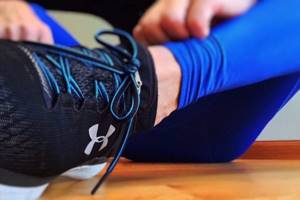
Under no circumstances should you exercise barefoot, wearing socks, slippers, sneakers or other inappropriate shoes, even if they are called sports shoes. Only sneakers that securely secure the ankle!
Rule No. 6. Regularity of classes
The number of workouts should be no more than three to four times a week. This is quite enough to tone your figure and feel more alert and energetic.
Before increasing the duration or number of exercises, think about the health of your joints - constant stress has an adverse effect on them.
Rule No. 7. Use of weights
Never use weights for aerobic exercise. They increase the load on the ankle and knee joints, as well as on the spine as a whole. With their help, you will be able to achieve an ideal figure earlier, but the price will be too high - you are guaranteed to have problems with joints. But during power loads, weights will only be a plus.
Rule No. 8. Motivation and emotional component
Only activities that give pleasure will help you achieve what you want. That is why a good instructor will always praise you, encourage you and give you hope that just a little more and... you will achieve your goal.
And it is true! The emotional component is very important. A person concerned about his excess weight must believe in himself and know that training is good for him.
You should not switch to complex exercises ahead of time; if they do not work out, then interest in the exercises will gradually fade away.
Effective exercises
Most complexes can be performed not only in the gym with a trainer, but also at home. This applies to both simple and advanced exercises. The most effective of them allow you to intensively burn fat in the buttocks and thighs.
- Platform squats. Feet are placed hip-width apart, then step onto the step. Standing on it with both feet, they squat, moving their pelvis back and closing their hands in front of their chest. Having straightened, your legs are lowered to the floor one by one. This is one repetition.
- Squats with leg abduction. They perform it almost in the same way as the previous one, but when stepping onto the step, they raise the second leg to the side and do a shallow squat on the first, after which they place their legs on the floor in turn.
- Jumping. The exercise is simple - from the “legs together” position, jump onto the platform, placing them parallel to the shoulders and doing a squat. Return to the floor at a walk, placing your feet one at a time. Jumping jacks are especially beneficial for the buttocks.
- Plank with steps. Trains the whole body. In prone position, palms are placed on the platform, legs together. Then alternately take “steps” with your feet to the sides and back to the center.
- Lifting the pelvis. The exercise is good for the legs, as well as for the abdominal muscles. You need to lie on the floor, place your feet on the platform and bend your knees; hands behind the head. Smoothly raise and lower the pelvis, feeling the load on the gluteal and quadriceps muscles. You can make the exercise more difficult by placing one leg on top of the other.
To make platform squats easier, you can move your leg forward or swing it, and squat on both legs.
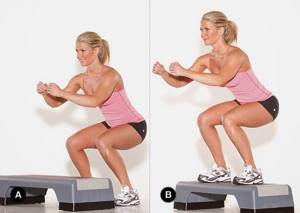
Platform squats

Squats with leg abduction
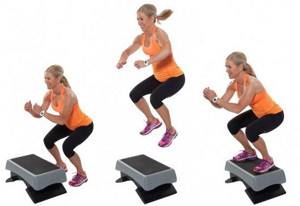
Jumping up

Plank with steps
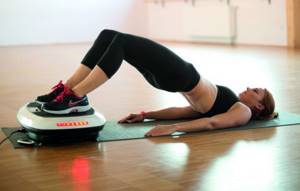
Pelvic lift
Step aerobics for beginners
Exercises on the step platform are not difficult. They are available to people of any age and level of physical development. The main thing is to choose a comfortable pace for yourself.
Basic exercises
Step exercises for beginners include several basic movements.
Exercise No. 1 (basic):
- step onto the middle of the platform with your right foot on your full foot, transferring your body weight to it;
- a similar step with the left foot;
- returning the right leg to its original position on the floor;
- return left.
Exercise No. 2 (V-shaped – V-step):
- step with your right foot to the right edge of the platform;
- a similar step with the left, only in the opposite direction;
- return to the starting position.
Exercise No. 3 (with shin cross or Curl):
- step with the right foot to the left edge of the platform;
- at the same time the left one swings back so as to touch the buttock with the heel;
- return to starting position;
- repeat with the left foot in the opposite direction.
Exercise No. 4 (knee up):
It is performed similarly to exercise No. 3, only the leg is bent at the knee not back, but forward and moves towards the chest.
Exercise No. 5 (leg lift - Kick up):
The same as exercise No. 4, but the leg is straight.
Exercise No. 6 (reverse movements):
- starting position – stand straight with both feet in the middle of the platform;
- alternately stand on the floor with one foot and then the other.
Exercise No. 7 (leg swing back):
- starting position - stand in front of the platform;
- step with the right foot to the left edge - the left leg is moved back, the knee is not bent, the arms are simultaneously extended forward;
- return to original state;
- repeat the movements with the left leg in the opposite direction.
Exercise No. 8 (leg swing to the side):
- step with your right foot to the center of the platform;
- the left leg is moved to the side and raised as high as possible, try not to bend it at the knee;
- the left arm accordingly also extends to the side, and the right arm bends at the elbow;
- return to starting position;
- repeating movements in the opposite direction.
More complex exercises
After you have mastered the basic exercises perfectly, you are tired of them and it is not difficult to perform them, you can begin a more complex program.
Such complexes include many exercises, for example, jumping on the platform itself, through the platform, with legs abducted, and others. Every fitness instructor should see that his students are ready to move to a more complex level of load, and only then gradually introduce new exercises into the training.
It is worth noting that complicated techniques are more suitable for young and healthy people who do not suffer from serious illnesses or excess weight. For others, it is recommended to stay at the basic level so as not to put stress on the joints and heart.
Basic elements and technique for their implementation
For beginners, step aerobics turns out to be more difficult than expected. Before mastering the steps, you need to remember the main rules: the heel should not hang from the platform, take 2-3 sips of water every 10 minutes of exercise, choose breathable, elastic clothes. An increase of 5 cm in platform height gives +12% to the load, so start from the minimum. The correct body position is:
- straight back, stomach pulled in;
- legs slightly bent;
- buttocks are tightened and tense;
- shoulders straightened, gaze directed forward.
The first of the main steps in any combination is the Basic Step. Standing in front of the platform, take a step onto it with your entire foot, then place your second leg next to it. Then they step back with the first foot, onto the floor, and place the second foot next to it. This counts as one step.
The second step is Knee up (no up) with a knee lift. Stand with one foot on the opposite corner of the platform (crosswise), bend the other and pull it towards the stomach. Then the legs are placed alternately on the floor.
During steps with the knee raised on the steppe, the muscles of the thighs and buttocks are well worked out.
V-step steps - feet are placed on different ends of the platform in turn. The limbs form an English V. When performing such manipulations, you must be careful not to slip off the stand.
A few more steps are performed in the same way as a no-up, only when climbing onto the platform, the leg does not go to the stomach, but forward, to the side, an overlap or a backward swing is made. There is also a variation of the basic step, when the foot does not fall to the floor at all, but only touches it.
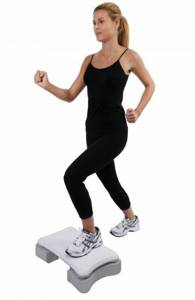
Basic Step

Knee up
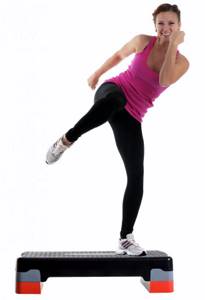
V-step
Equipment for classes
To feel comfortable during training, you need to dress properly and also have the necessary sports equipment. If you are working out in a group, then the fitness club already has step platforms, but for home exercises it is better to purchase professional “steps” than to use improvised material.
Step platform
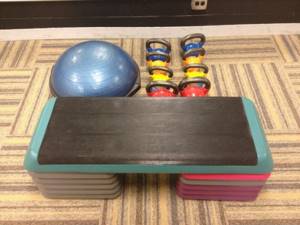
A modern “stepping platform” is manufactured to be stable and safe. It is made of durable plastic, and covered with an anti-slip rubber coating on top, which is necessary for shock absorption and stability.
The length of the platform is 80-120 cm, width is 35-40 cm, and the height can be adjusted in three levels. Depending on the manufacturer, the height levels are:
- 10-15 cm;
- 15-20 cm;
- 20-25 cm.
Clothes and shoes
As noted above, step training should be carried out only in sneakers that provide good support for the ankle joint. They will protect him from possible injuries, sprains and dislocations.
It is recommended to give preference to special running shoes because:
- they have a good springy sole;
- there are ventilating inserts that provide “breathing” to the legs;
- under the heel and on the foot there are special “pads” filled with air for a shock-absorbing effect and softening impacts on the surface.
As for clothing, it should be comfortable and convenient. Since you will be doing physical activity, choose breathable fabrics made from natural materials. It is advisable to avoid long and wide sweatpants to avoid stepping on the pant leg during exercise.
Platform options
The size requirements for the manufacture of this simulator are as follows:
- The width of the upper working surface must be such that the athlete’s foot can freely fit on it. At the same time, it should not be too wide so that one can easily step over it. The optimal width, depending on the size of the leg and height, will be from forty centimeters to half a meter.
- The height of the step platform depends on the level of training of the athlete. For beginners, this size should be from ten to fifteen centimeters, over time it increases to thirty. It has been proven that increasing step height by five centimeters adds up to 12% strain on muscles.
- The length of the board is one to one and a half meters. The parameter depends on the comfortable position of “legs slightly wider than shoulder width.” With this positioning of the body, the feet should not hang over the edges and should stand straight. This way you can choose the optimal length.
Reviews from women
- “This is a very energy-intensive type of training, after which you feel like a wrung-out rag. But the body becomes lighter and more toned. I’ll say right away that if you don’t limit yourself in diet, you definitely won’t be able to lose weight. I eat a lot, I don’t want to reduce my diet, I haven’t lost a kilogram, but I’m always cheerful and energetic. I don’t feel like a broken sourdough!”
- “Step aerobics is ideal for obese people. Ordinary jumping and running are contraindicated for fat people; they have a detrimental effect on the joints and heart. In addition, it is based on cardio exercises plus strength training. This combination helps to tidy up your figure. True, you will have to work hard.”
- “Do you want to tighten your hips and reduce your waist size? Then do step aerobics. It also trains the heart and respiratory system.”
- “I believe that only certain muscle groups are trained, mainly the legs and hips. Besides, it’s monotonous, boring and stupid - you’re pacing back and forth.”
- “It’s just the thing as a shake-up for the body, but it’s too much of an unjustified load on the legs and joints. Why do I need extra muscles on my legs and buttocks? The fat still remains in place, and after three months of training the volume only grows in the form of muscle mass.”
- “The training is exciting and fun, but then everything hurts so much!”
- “If you exercise at a frantic pace, then excess weight can be lost without difficulty. But the exercises are too monotonous, it becomes boring.”
- “If you have problems with your back or knees, it’s better not to even start.”
- “The results are excellent, but the training is very exhausting.”
- “Do you want to feel like a cornered horse? Then sign up for step aerobics. Moreover, the result of losing weight will be controversial.”
Doctors' opinions on the effectiveness and safety of training
You can often hear statements that step aerobics “kills” the knee joints and ankles.
Is this really so or is it the machinations of skeptics and envious people? If you are obese, then your joints are at risk in any case. And if you are already over 35, then the deficiency of female hormones gradually makes itself felt through thinning of the bones and the development of osteoporosis. It is desirable to reduce the impact loads on joints and bones as much as possible, and step aerobics is designed specifically for them, especially if you do it intensively, wanting to lose weight.
We can conclude that this is fitness for young and healthy people. And for slightly older women, it is better to pay attention to static loads that do not require jumping and steps, after which creaks and pain in the knees will appear.
Recommendations for increasing the effectiveness of classes
If you want to lose weight and improve your fitness through step aerobics, use the following tips.
- Spend several sessions learning the basic steps and elements. Step aerobics for beginners will help you with this, or rather, a few basic movements given below.
- Never skip warming up and stretching. They help avoid injury and relieve muscle pain during and after exercise.
- Exercise regularly. Do step aerobics at least 3 days a week. If you are determined to intensively lose weight, add 1 more session.
- When doing step aerobics, do not forget about safety. Skip class if you feel sick, weak or dizzy. Like other forms of cardio exercise, step aerobics is intense and will require your full commitment.
